Want to save money and be a hit with your hungry family? Then, stick around to learn how to make breakfast sausage links from scratch. I did the maths and managed to save over $160 by making a 50lbs batch versus buying the same amount.
We’ve outlined step-by-step instructions below, or you can follow along with the video. Either way, let me show you how fun and budget-friendly it is to make flavorful breakfast sausage links.
Making your own breakfast sausage is a real money-saver
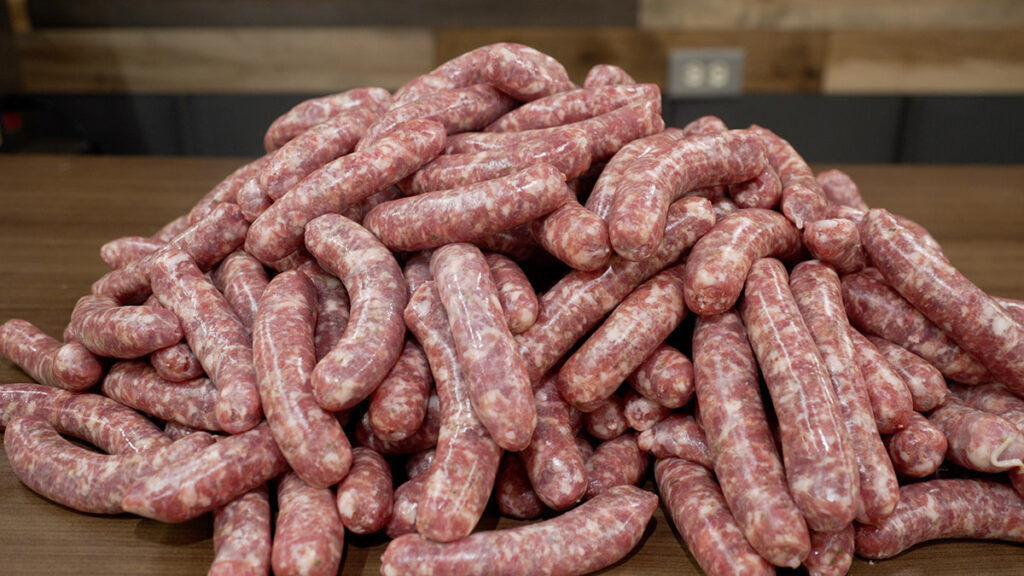
One of the greatest things about making your own breakfast sausage is that you can save money. I did some math and compared making 50lbs of breakfast links versus buying 50lbs. 50lbs of breakfast links at my local grocery store would cost me $326. Making them myself? Exactly half that price: $163.
So, if you’re reluctant about spending the money on a grinder, rest assured you’ll make the money back in a few batches.
Plus, you made them, so you know what they’re made of, and between you and me, homemade sausage links taste much better than store-bought ones.
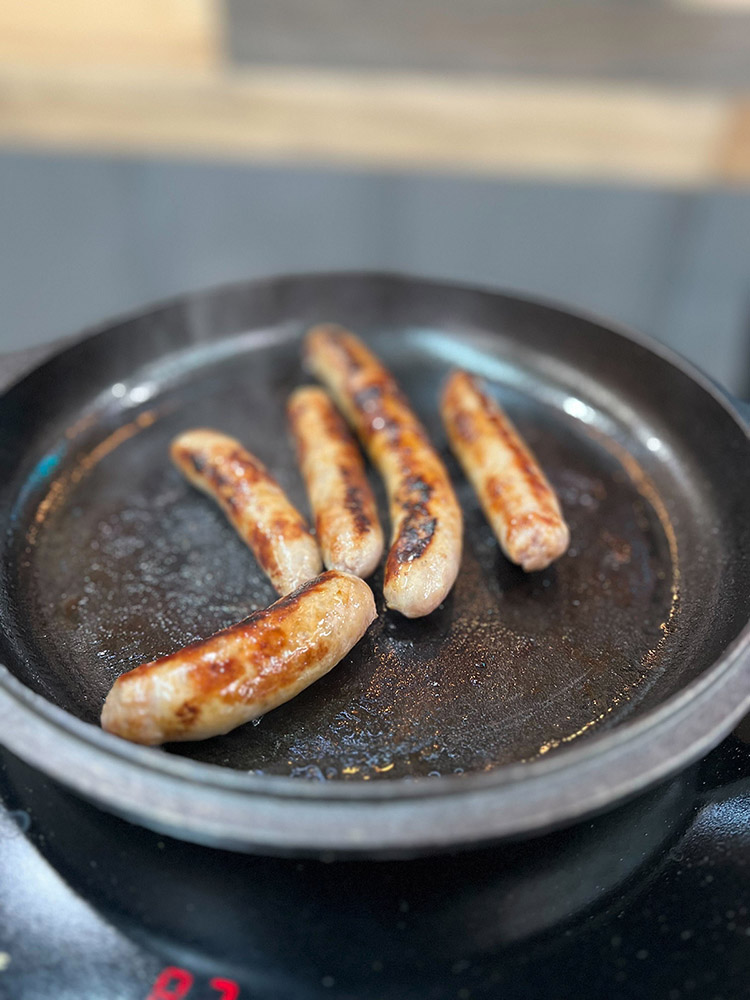
Ingredients you’ll need
- Natural sheep casings – I get mine from PS Seasoning, but you can easily find them online at retailers like The Sausage Maker, Waltons, or Amazon. You might even find them at your local butcher.
- Pork butt – this can be boneless or bone-in, and this recipe uses 25 pounds.
- Seasoning – I’m giving you two options. You can use PS Seasoning’s No. 117 Breakfast Sausage Seasoning and No. 274 Maple Sausage Seasoning, which combines maple sugar with spices. Or you can make a homemade seasoning, which I’ll put in the recipe card at the bottom of this page.
Equipment you’ll need
What meat to use for breakfast sausage?
The first thing you need to know is I always use pork butt when making breakfast sausage links at home. It has the perfect fat-to-meat ratio, and it’s typically priced pretty well, a.k.a. it won’t break the bank like some other meat cuts nowadays! I recommend shopping around, as you never know when you’ll stumble upon a sale.
While I often use a bone-in pork butt, I have to admit that it’s a pleasant surprise when I find boneless pork butt for the same price. It’s much easier to slice and cube boneless, saving effort and prep time.

Which seasoning is best?
Whenever I decide to dirty up my grinder, I do at least a 25-pound batch. This is also handy when using PS Seasoning’s seasoning packets, which are made for 25 lbs of meat.
I recommend beginners start with store-bought seasoning before venturing into DIY-style. Figuring out the right amount of herbs and spices needed to make a homemade recipe can be tricky as there’s some science behind it.
But once you get some experience, you should start experimenting. If you need extra guidance, check out the book Home Production of Quality Meats and Sausages. It includes a very valuable spice table with measurements that many professional sausage makers use so they don’t add too much spice to their mixture.
You need to keep everything cold
My number one tip for making sausage is to keep your meat and grinder cold throughout the process.
I’m lucky to have a natural refrigerator outside, but you can use your actual fridge with equally good results.
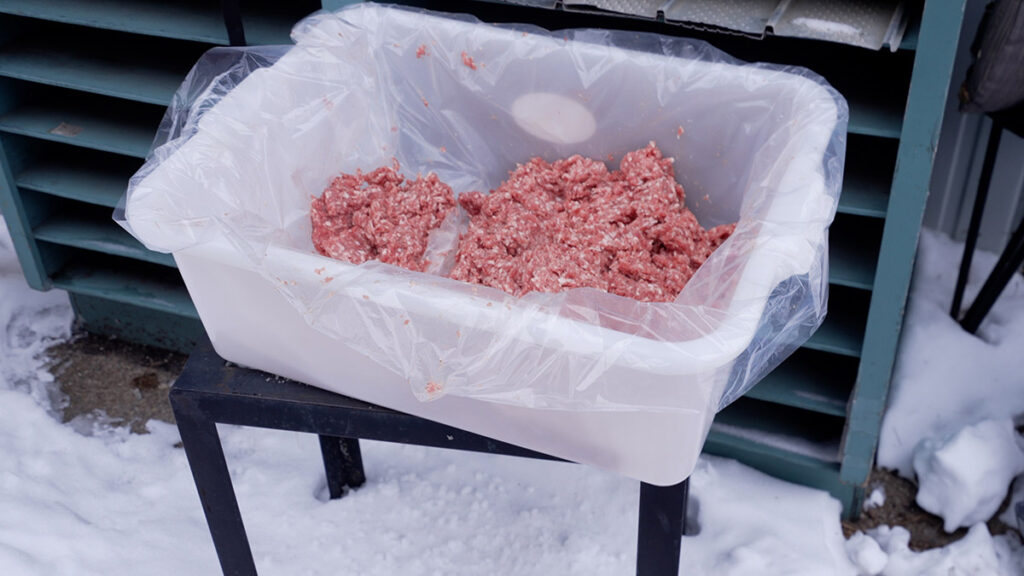
You want to avoid the fat warming up, as this can ruin the texture of the sausage. It’s also good food safety to keep everything cool.
How to make breakfast sausage links at home
1. Prep the sheep casings
To prep the casings, I take them out of the package and rinse them well under water to remove the excess salt. I then let them soak in warm water for about an hour.
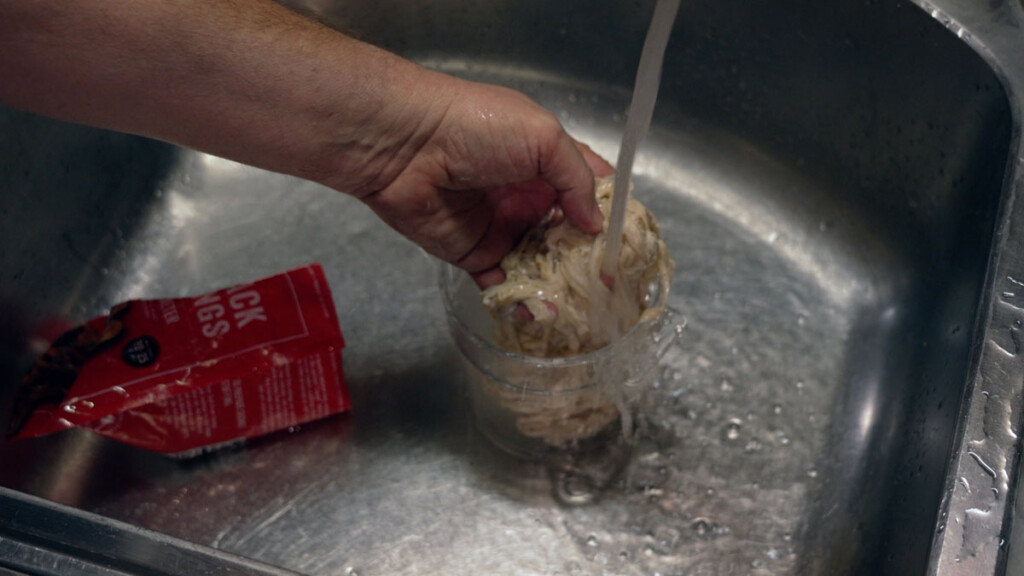
When the hour is up, rinse them off again. Then, put them back in the same water-filled container and let them soak in the fridge overnight.
Pro tip: Add a teaspoon of baking soda to the container before placing it in the fridge. This helps the casings become slippery and makes sliding them on the horn much easier.
2. Prep the pork butt
Fortunately, it’s not hard to remove the bone from a pork butt. Just find it with your knife and start cutting it out.
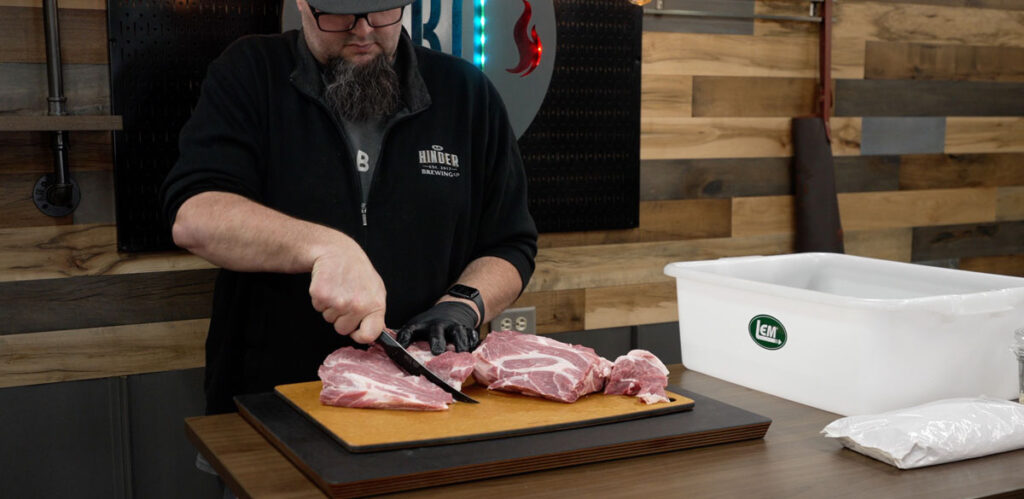
I promise there’s no right or wrong way to do it; you can clean it up as much as you want. If you find boneless pork butt, you can skip this step and just slice it up.
As for how to cut pork butt, there’s also no right or wrong way. I just go with whatever size and shape fits best in my grinder. Sometimes, I do strips; other times, I cube them to fit down that throat.
3. Add seasoning
As mentioned, you’ve got two options for seasoning. Either way, add it to the container, don your gloves, and get mixing by hand. I find this is the best way to ensure every bit of pork butt gets some flavor.
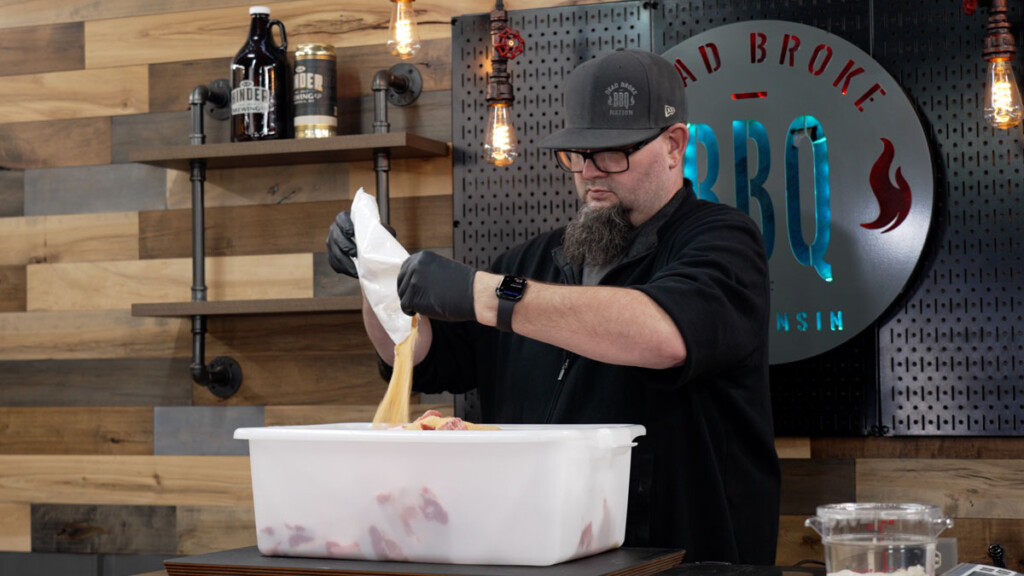
When the meat’s nicely seasoned, place it in the fridge to cool down. There’s nothing better than grinding almost-frozen meat.

Make sure the seasoning is evenly mixed through the meat.
4. Grind the meat
Now, how I grind my meat depends on the grinder. If I’m using my LEM Dual Grind #22 Big Bite Meat Grinder, I do one single pass through my 3/16-inch plate or my ¼-inch plate.
I’m sure most of you reading this don’t have a dual grinder, though, so in that case, you’ll want to send that fresh sausage through twice.
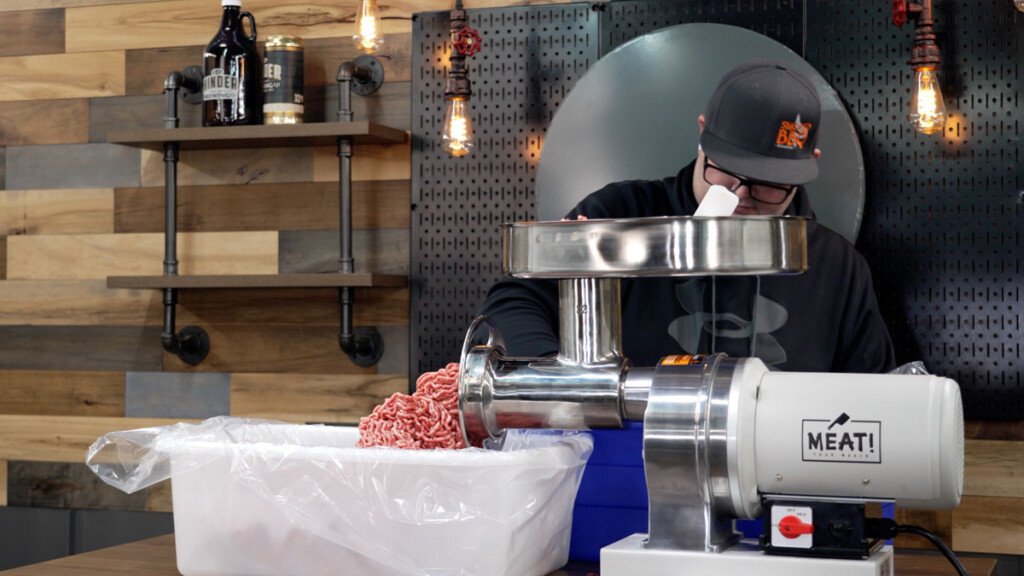
I grind my meat twice when I’m using my 1.5HP Meat! Your Maker Grinder.
If this is your first time using a grinder, be sure to check out our guide to grinding meat.
No matter which grinder I use, I always hand-mix the fresh sausage afterward for at least 5 minutes to kick the protein extraction into high gear.
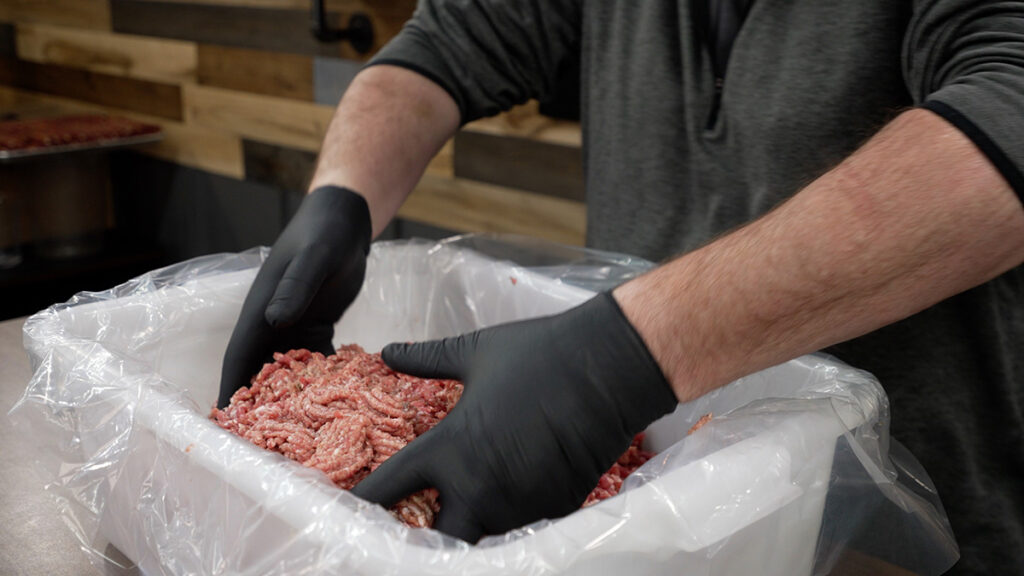
Use gloves to protect your hands from that freezing cold meat!
You know you have a good mix when it sticks to the bottom of your hand.
Pro tip: I highly recommend using cut-proof gloves to save your hands from that cold meat. I also regularly use them when cutting meat because they double as liners.
At this point, you could always form the meat mixture into patties and fry them later. I’ll often reserve some meat for making patties.
5. Stuff the sausage
Before you start, you should grab a friend to help you. From personal experience, it’s easier if one person cranks at an even speed and the other person helps guide the sausage out.
When filling up your sausage stuffer, pack it nice and tight. That way, you can get all the air out between the handfuls of ground sausage you press in. This will help keep the sausage flowing out of that horn nice and consistent.
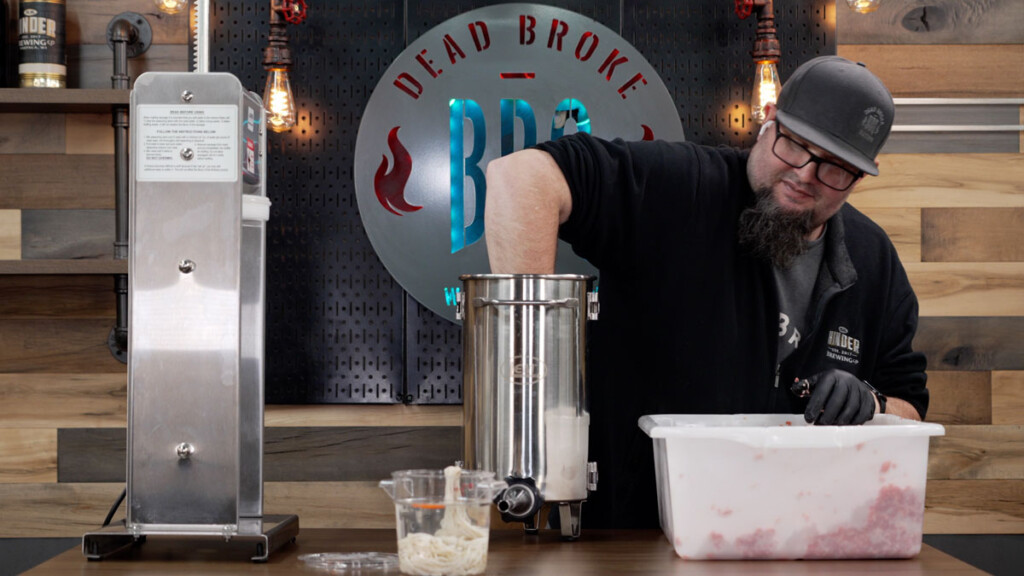
Pack that breakfast sausage meat in tight.
Now, you’ve got to place those soaked sheep casings on the ⅝ horn. It can be tricky if you have sausage fingers like I do. But once you get it, put a little water through the casings and slide them onto the horn. It will take some practice, but you’ll get it.
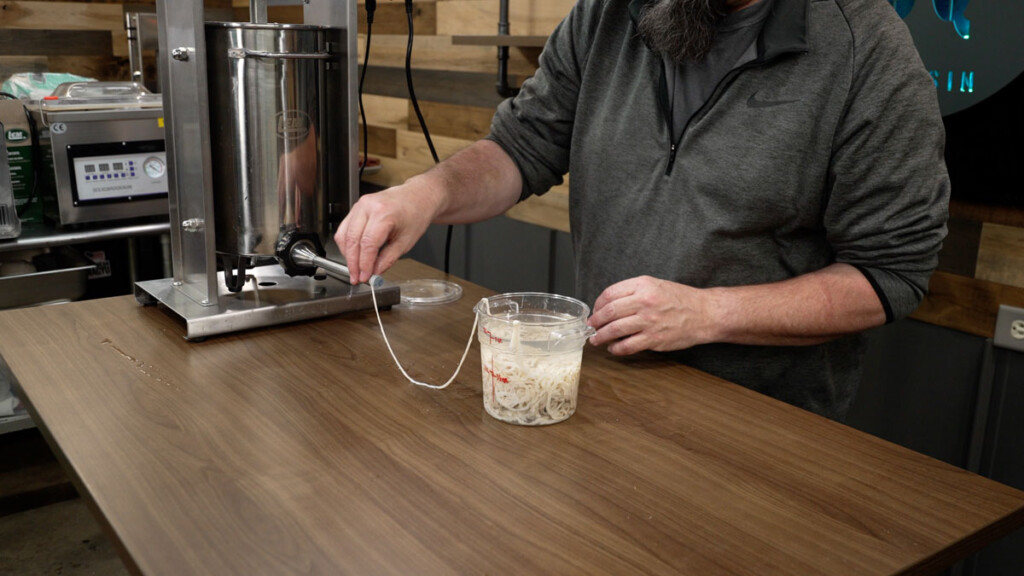
Pro tip: If you have leftover casings, place them back in the water-filled container in the fridge. They’ll stay okay for a couple of weeks. If you don’t use them for longer than that, add a little salt to the water so they don’t spoil. By adding salt, they can last up to 2 years.
When I’m filling natural sheep or hog casings, I only fill them to about ¾ full. That way, it’s much easier to pinch them off and spin them up nice and tight.
6. Make the links
Once all the pork sausage is stuffed and coiled, it’s time to make the links. I don’t pay too close attention to my link size. I just start pinching and twirling. But typical breakfast sausages are about 4 inches.
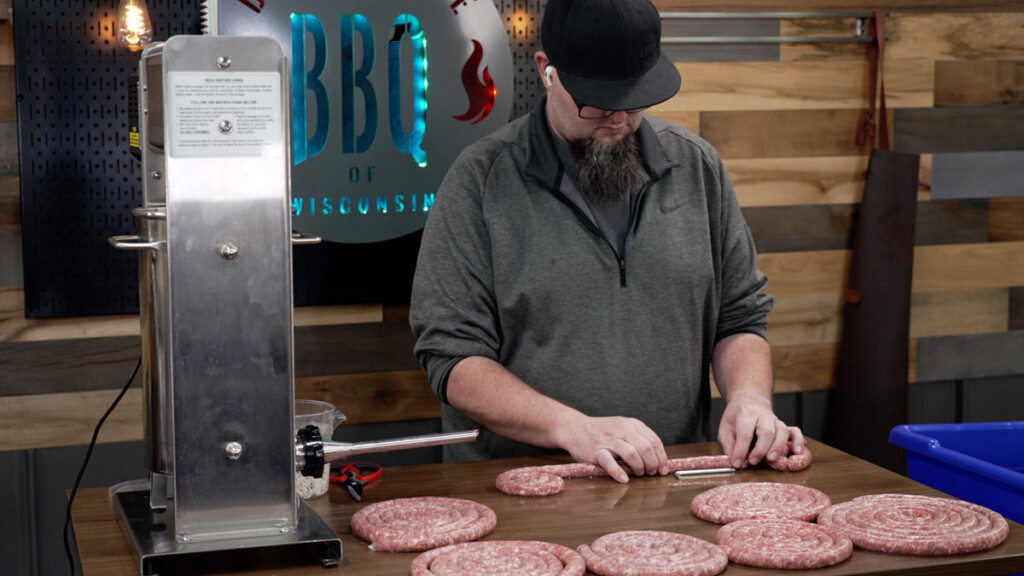
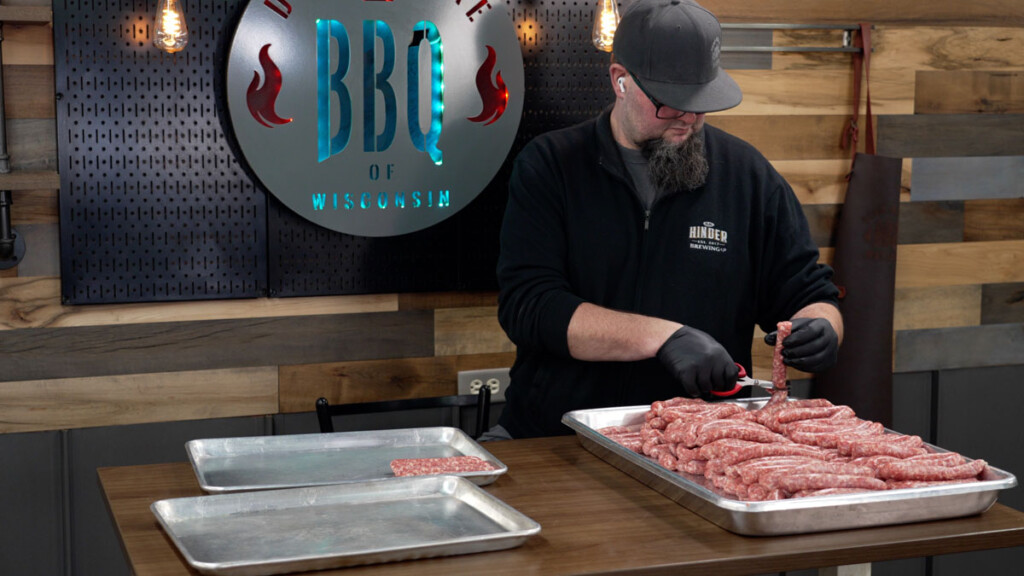
Just like that, you’ve made homemade breakfast sausage links!
How to store sausage links
The uncooked sausages can be refrigerated in an airtight container for a week or frozen for up to 3 months.

How to cook breakfast sausage links
There are several ways you can cook breakfast sausage links:
- Cook them in a frying pan over medium heat. Fry them for about 3 to 4 minutes on each side until they’re brown and reach an internal temperature of 155 degrees.
- Cook them in a 400-degree air fryer for about 7 minutes or until they reach the above internal temp.

Enjoy smoked sausage, of course. Head here to learn how to smoke sausage at home.
Print
How to Make Homemade Breakfast Sausage Links
Prep Time 1 hour hour
Cook Time 8 minutes minutes
Servings 50 people
Calories 300kcal
Author Jeff Rice
Homemade Seasoning (optional)
- 1 tbsp salt
- 1 tsp black pepper
- ¼ tsp nutmeg
- ⅔ tsp ginger
- 1 tsp dried thyme
- ¼ tsp cayenne pepper
Rinse the sheep casings well under water to remove the excess salt. Then let them soak in warm water for about an hour before rinsing again, putting them back in the same water-filled container with a teaspoon of baking soda, and letting them soak in the fridge overnight.
Prep the pork butt by removing the bone if necessary and then cutting it into cubes that’ll fit in your grinder.
Add the seasoning of your choice to the container and mix it in with glove-covered hands.
Place seasoned meat in the fridge to cool down.
Depending on the grinder, grind the meat once or twice using a 3/16-inch plate or a ¼-inch plate.
Mix the fresh sausage by hand for at least 5 minutes until it sticks to the bottom of your gloved hand.
Pack the ground pork nice and tight into the sausage stuffer. Add a little water and slide the soaked casings onto the horn, then fill the casings about ¾ full.
Take your stuffed and coiled sausage and pinch and twirl it into the link size of your choice.
If you would rather make breakfast sausage patties for frying just skip the sausage making process. Once you’ve finished grinding and seasoning the meat, just form the patties by hand.
Calories: 300kcal | Carbohydrates: 0.1g | Protein: 42g | Fat: 13g | Saturated Fat: 5g | Polyunsaturated Fat: 1g | Monounsaturated Fat: 6g | Trans Fat: 0.1g | Cholesterol: 136mg | Sodium: 287mg | Potassium: 770mg | Fiber: 0.02g | Sugar: 0.005g | Vitamin A: 5IU | Vitamin C: 0.02mg | Calcium: 32mg | Iron: 3mg
Did you miss our previous article...
https://manstuffnews.com/backyard-grilling/the-ultimate-colcannon
 Backyard GrillingWeekend WarriorsAdvice from DadBeard GroomingTV Shows for Guys4x4 Off-Road CarsMens FashionSports NewsAncient Archeology World NewsPrivacy PolicyTerms And Conditions
Backyard GrillingWeekend WarriorsAdvice from DadBeard GroomingTV Shows for Guys4x4 Off-Road CarsMens FashionSports NewsAncient Archeology World NewsPrivacy PolicyTerms And Conditions
